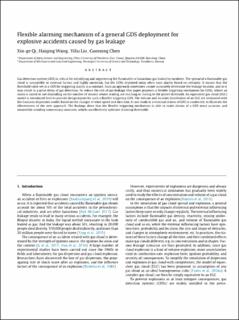| dc.contributor.author | Qi, Xin-ge | |
| dc.contributor.author | Wang, Haiqing | |
| dc.contributor.author | Liu, Yiliu | |
| dc.contributor.author | Chen, Guoming | |
| dc.date.accessioned | 2020-03-31T13:07:57Z | |
| dc.date.available | 2020-03-31T13:07:57Z | |
| dc.date.created | 2020-01-09T17:43:26Z | |
| dc.date.issued | 2019 | |
| dc.identifier.citation | Process Safety and Environmental Protection. 2019, 132, 265-272. | en_US |
| dc.identifier.issn | 0957-5820 | |
| dc.identifier.uri | https://hdl.handle.net/11250/2649702 | |
| dc.description.abstract | Gas detection system (GDS) is critical for identifying and suppressing the flammable or hazardous gas leaked by incidents. The spread of a flammable gas cloud is susceptible to external factors and highly uncertain, but the GDSs deployed today often raise alarms based on certainty. It means that the threshold value set in a GDS for triggering alarms is a constant. Such an approach sometimes cannot accurately determine the leakage location, and so it may result in a great delay of gas detection. To reduce the risk of gas leakage, this paper proposes a flexible triggering mechanism for GDSs, where an alarm is raised or not depending on the number of sensors whose reading are reaching or closing to the preset threshold. An equivalent gas cloud (EGC) model is introduced here to provide design inputs for such a flexible triggering GDS. The volume and location distribution of an EGC are estimated with the Gaussian dispersion model, based on the changes of wind speed and direction. A case study in a terminal station of LNG is conducted, to illustrate the effectiveness of the new approach. The findings show that the flexible triggering mechanism is able to make alarms of a GDS more accurate, and meanwhile avoiding unnecessary measures, which can effectively optimize alarming thresholds. | en_US |
| dc.language.iso | eng | en_US |
| dc.publisher | Elsevier | en_US |
| dc.rights | Attribution-NonCommercial-NoDerivatives 4.0 Internasjonal | * |
| dc.rights.uri | http://creativecommons.org/licenses/by-nc-nd/4.0/deed.no | * |
| dc.title | Flexible alarming mechanism of a general GDS deployment for explosive accidents caused by gas leakage | en_US |
| dc.type | Peer reviewed | en_US |
| dc.type | Journal article | en_US |
| dc.description.version | acceptedVersion | en_US |
| dc.source.pagenumber | 265-272 | en_US |
| dc.source.volume | 132 | en_US |
| dc.source.journal | Process Safety and Environmental Protection | en_US |
| dc.identifier.doi | 10.1016/j.psep.2019.10.001 | |
| dc.identifier.cristin | 1769803 | |
| dc.description.localcode | © 2019. This is the authors’ accepted and refereed manuscript to the article. Locked until 17 October 2021 due to copyright restrictions. This manuscript version is made available under the CC-BY-NC-ND 4.0 license http://creativecommons.org/licenses/by-nc-nd/4.0/ | en_US |
| cristin.unitcode | 194,64,92,0 | |
| cristin.unitname | Institutt for maskinteknikk og produksjon | |
| cristin.ispublished | true | |
| cristin.fulltext | preprint | |
| cristin.qualitycode | 1 | |

